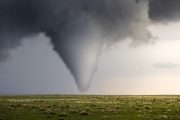One year after the tornado
A year ago, a tornado hop-scotched through our town. It was past midnight, and I was watching a movie at home with our teenagers. When our phones screamed a long, loud beep, we switched to local news to see a meteorologist — sleeves rolled up to the elbows — urging viewers to get into a safe place. A tornado had been  spotted in the heart of town.
spotted in the heart of town.
For the next 10 minutes, we huddled in a closet under the stairs, listening to the staccato sound of hail. We heard the warning sirens wail and felt our ears pop. I remember gripping the closet doorknob, praying the door would stay closed and be a barrier between us and the storm. After an ear-splitting sound, the wind began to calm.
When we peered out of the closet, this comforting old house surrounded us with intact walls and roof. But when we opened the front door to look outside, we stared straight into a vertical wall of dirt and roots that I couldn’t make sense of in the dark. It wasn’t until I walked right up to it with a flashlight that I realized the giant oak tree that had always towered a few feet from our door was now on its side. I was looking at the bottom of the root ball that had ripped from the ground to point skyward as the tree toppled. If it had fallen toward the house instead of the street, it would’ve come down on top of us.
By daybreak, we and our neighbors were already helping each other clean up. Later that day, we drove around to get a broader glimpse of what the storm had done once it left our street. The familiar landscape had drastically changed — so different that I felt disoriented, as if I’d taken a wrong turn and gotten lost in my own town. The local news confirmed that our area had suffered losses in lives, homes, cars and businesses.
A twister may only last for minutes, but there’s a cascade of fallout for months afterward. Some homes and businesses bounced back relatively quickly, while others languished in complicated situations with insurance companies and a drought of cash flow. Some eventually rebuilt, but others were lost amid the impossible circumstances that disasters leave behind.
One of those places was a little diner called The Waffle Hut, which had been part of our town for several decades. When my parents moved here 13 years ago, the diner became my dad’s favorite place to go. He sat on a barstool at the counter, ate breakfast, and turned strangers into friends with his proximity and good nature.
After his dementia made it unsafe for him to drive, I went to Waffle Hut with him every weekday after dropping off the kids at school. I sat on a stool beside Dad, read the news, and visited with people around us. The diner became our “third place.”
When home is the first place and work is the second, third places are defined as spots where people regularly gather and interact. And our third place had the best crispy hash browns and the kindest people. It wasn’t fancy, but people waited in line on weekends just to get in the door.
Even after Dad couldn’t remember the name of his usual breakfast order, the waitresses remembered for him — a waffle with blueberry topping. The cooks loved him like family and listened to him tell stories and jokes he’d already told dozens of times. One of our last photos of him was taken inside that diner, grinning at us over an orange coffee cup. A month later, he was gone.
One year ago, the tornado pried open the diner’s roof, sucked out the contents and spewed them into the whipping winds. After several months in limbo, the owners of the leased building decided not to rebuild. Those of us who loved that little place mourned the loss of a community treasure that had given us a space to start the day among friends.
I saw the diner for the last time a few weeks ago when I drove by and noticed that a demolition excavator with a hydraulic claw was parked nearby, preparing to finish what the tornado had set in motion. On the diner’s windows, someone had spray-painted the words “We will miss you.”
I haven’t driven down that block since then because I dread seeing an empty slab where the diner once stood. That void would’ve broken Dad’s heart. But I also know that demolition and even death can’t destroy the joy and memories. We carry those with us.
On any given day in all kinds of weather and circumstances, love your people and your places. We live in an impermanent world, and we’re almost never ready to see it change.
Gwen Rockwood is a syndicated freelance columnist. Email her at gwenrockwood5@gmail.com. Her book is available on Amazon.
